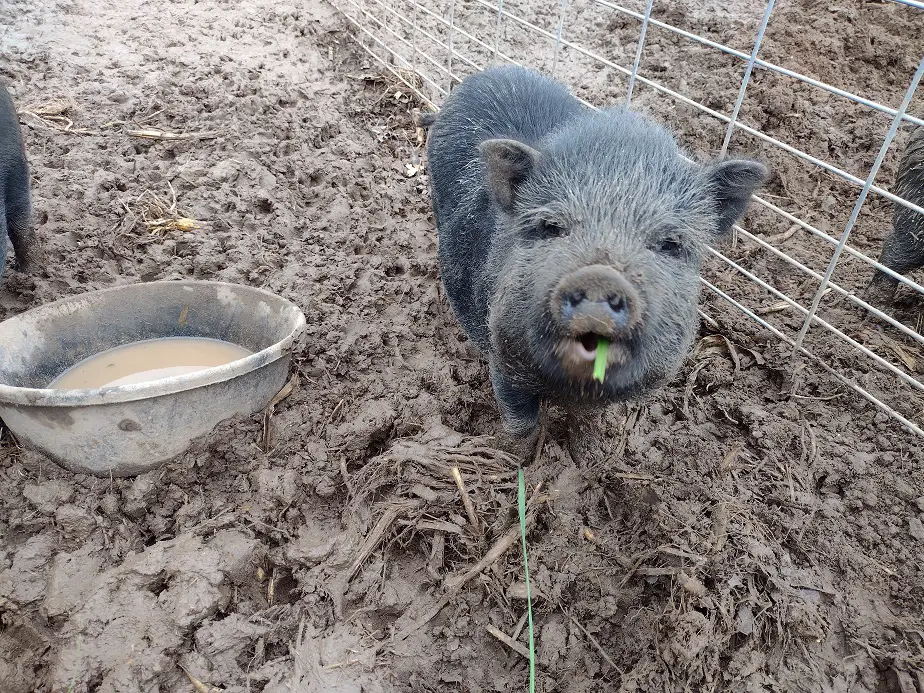I don’t have the space or money for inefficient animals. Practicality has to come first.
The most efficient animal for meat are rabbits, pigs, and chickens. They are easy to care for, have great feed conversion ratios, and can be kept in small areas. Sheep or goats can be decent in some scenarios. Beef cattle are perhaps the most inefficient animals to raise for meat.
I’ll go in-depth into the most likely best options so you can make a good decision.
The Most Efficient livestock for Your Homestead
This chart explains what stands out to me as the largest points to consider when it comes to selecting livestock that will work for you.
| Meat Animals | Purchase price | Productivity | Feed conversion ratio/ feed type | Housing | Special care |
| Rabbits | $20 | 30 to 40 young/year | 2:1-4:1 greens-grain, or just greens | small wire cages w/ rain cover | must have shade, seldom brushing/ nail trimming |
| Pigs | $100 | 15-30 young/year | 3:1-5:1 moderate to high protein and calorie | stout outdoor pen, w/shelter in bad weather | must have some shade, worm annually. |
| Chickens (cornish cross) | $2 | Will not self- reproduce | 3:1-4:1 high-protein, High calorie | outdoor pen w/rain cover | keep warm, they have bad feathers, prone to overeating |
| Sheep | $400 | 2-4 young/year | 4:1-6:1 grains-greens, or just greens | simple pen or fence w/ shelter | limit copper in diet, adults need shearing |
| Goats | $400 | 2-4 young/year | 5:1-8:1 | simple fence or pen w/ shelter | none really |
| Cows | $750 | 1 calf/14 months | 5:1-8:1 | heavy pen or fence w/ large shelter | prone to pneumonia when young |
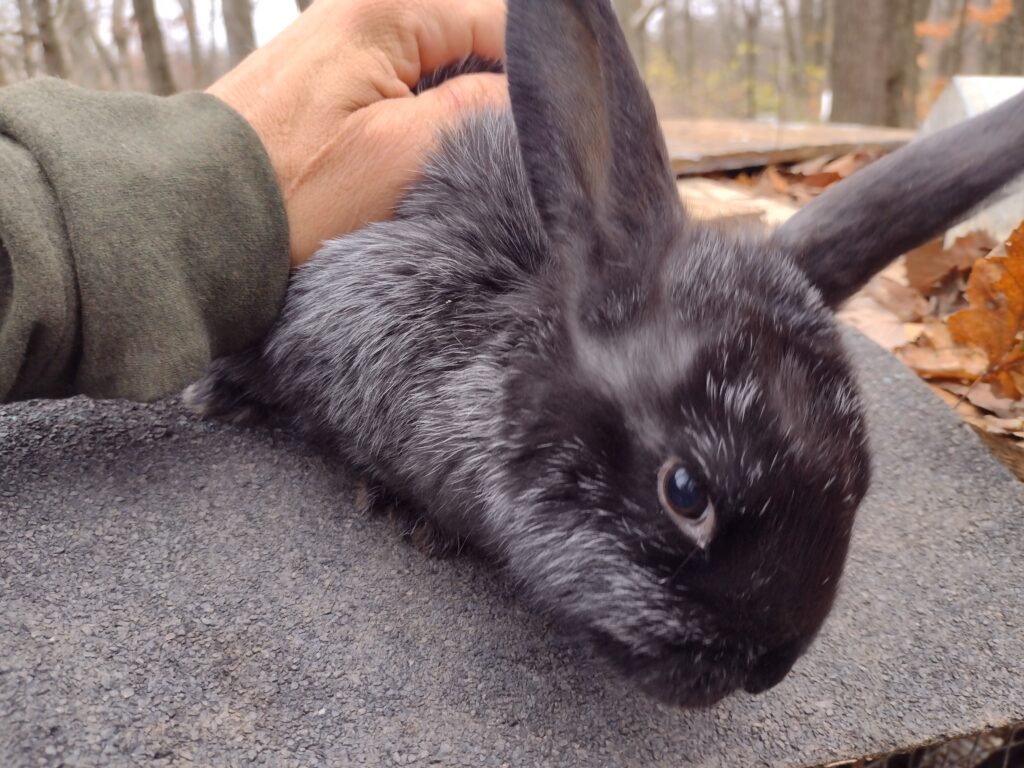
Meat Rabbits
Rabbits are generally considered the most efficient animal to raise for meat. They are highly productive, have simple housing needs, and can eat either commercial feed or pasture forage. Rabbits are usually the most simple animal for a family to raise for meat.
Most rabbits butcher out at around 50 percent of their live weight. Most any breed will work, but the best are commercial-type breeds. We raise the heritage breed, Silver Fox. The commercial breeds have meatier bodies and are bred more for a production model.
Good rabbits, when fed well, are butchered at 10-12 weeks and have a carcass weight of 2.5 pounds. Rabbits can have 4 litters a year without pushing them too hard. 8 bunnies is an average litter size, but some breeders average 12.
Two $20 rabbits can produce between 30 and 50 animals per year on a non-aggressive breeding schedule. Good meat rabbits should get to a weight between 1.5 and 2.5 pounds by 10 weeks old, depending on feed quality.
A single breeding pair averages 32 bunnies, yielding about 80 pounds of meat a year. That will take about 550 pounds of dry feed. It takes about 100 pounds of feed to feed a doe and her bunnies from breeding to butcher. 4 does can easily produce over 300 pounds of meat a year.
Rabbits are the most efficient animal with feed. Meat rabbits have a feed conversion ratio between 2:1 and 4:1, depending on feed quality. No other livestock can have a feed conversion of 2:1 outside of a factory farm setting. When fed a high-grain diet, rabbits outperform all other grain-fed animals in feed efficiency.
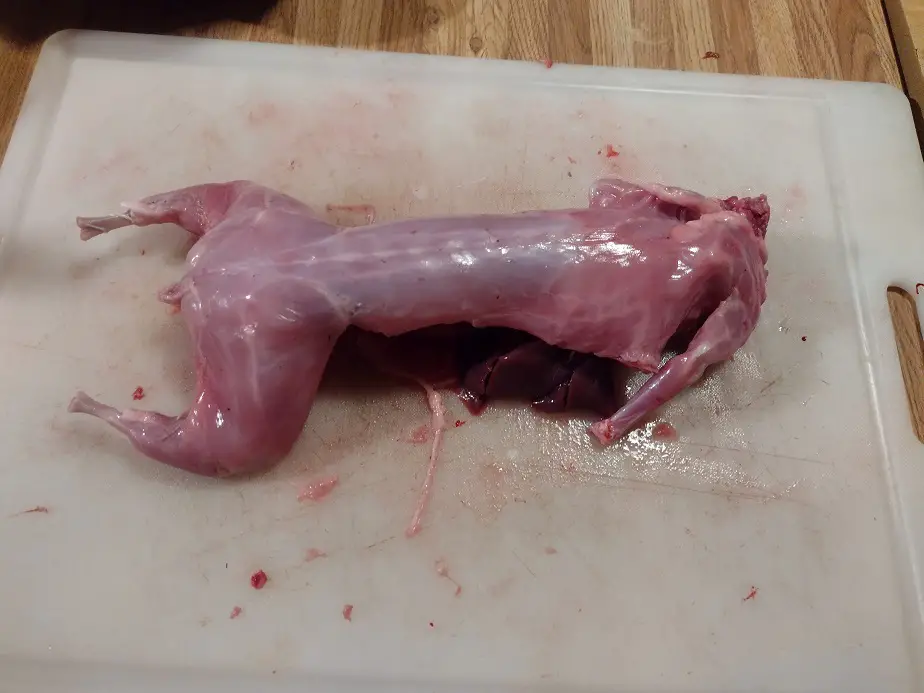
When only green plant matter, rabbits are more feed-efficient than all other grazing animals. They gain more per pound of feed used. Based on feed consumption alone, rabbits are significantly the most efficient animal. I’ll call them the most feed-efficient.
Rabbits are highly productive. A female usually gets bred 4 times a year and averages between 8 and 10 (but may be up to 15) bunnies per litter. One breeding pair can quickly turn into a larger breeding operation, and they can be bred at 6 months old. No other livestock is that productive so quickly.
With larger livestock, especially pigs and cows, people buy new ones every year. But with rabbits, you really only need to buy your initial breeders and they will produce all the animals you could ever want.
rabbits reproduce very easily and that adds a lot more to the efficiency factor as well. A few rabbit cages are cheaper than building a pig pen or fencing in a pasture. Rabbits are also easy for kids to handle.
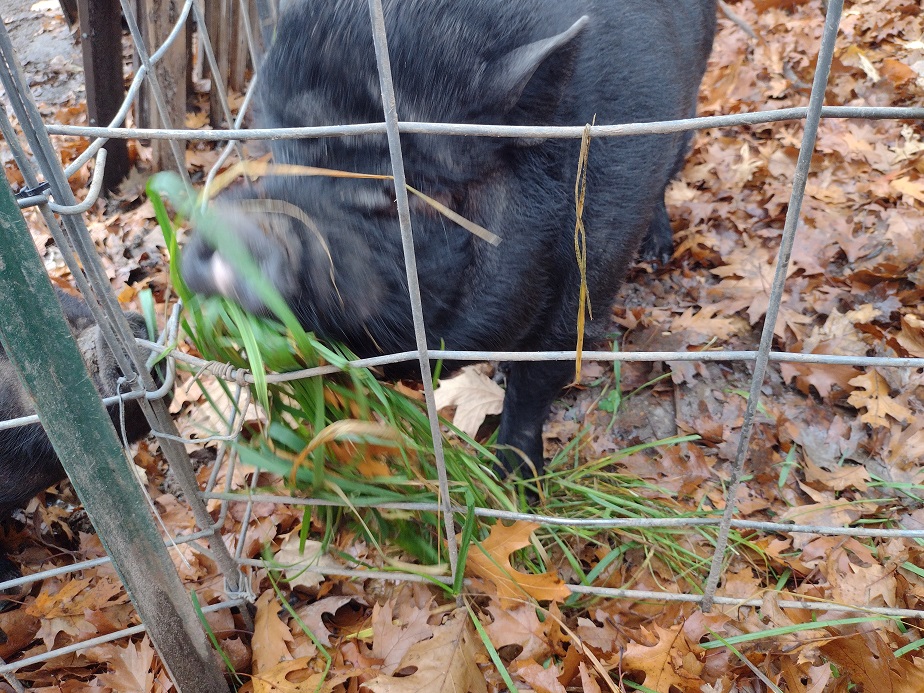
Pigs
Pigs have become my favorite animal to raise. Our pigs are productive, easy to raise and handle themselves well with little intervention. The only downside to pigs is that they can’t live on just greens or pasture, at least not for the most part. There are exceptions.
Pigs have simple stomachs, quite similar to people. They need a high-calorie, high-protein diet like we do. Commercial breed meat pigs eat an average 5,000 calories a day in their 6 months from weaning to butcher. Smaller breeds are sometimes more efficient with feed.
We raise common Potbelly pigs, which are very similar to the New Zeeland Kunekune (actually came from Asia). Pretty much every well-kept pig will butcher out at about 50 percent of live weight and eat about 3 percent of their body weight daily in the first 6 months.
Our pigs are about 1/5 the size of commercial hogs, which means the adults max out between 100 and 200 pounds. The piglets grow to around 50 pounds at 6 months, producing 25 pounds of pork each. Our pigs have litters of 8 to 10. That’s 200-250 pounds of pork per litter. Pigs can have 2 litters a year.
A single commercial hog will commonly eat 650 to 700 pounds of feed and weigh about 220 pounds at 6 months old. That should produce around100 to 120 pounds of pork. Large breed hogs will often grow 700+ pounds by 5 years. Those are hard to handle. Most breeders are butchered at 2 years old.
My pigs eat between 100 and 150 pounds of feed, depending on the time of year and how much is growing in the pasture. They eat more in winter.
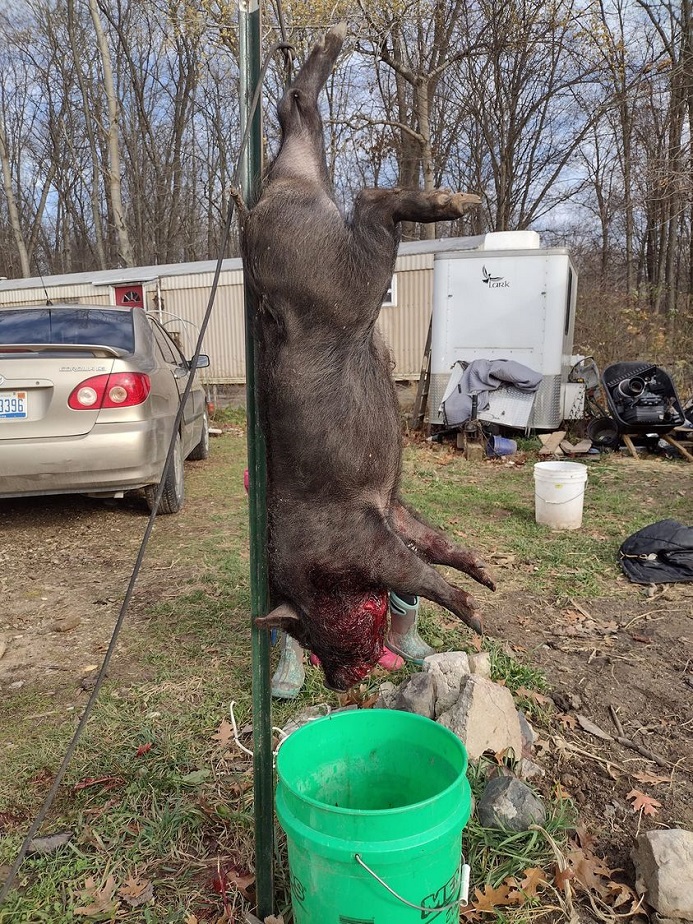
Pigs are usually butchered at 5 or 6 months to maintain feed efficiency. Older animals of any type require more pounds of feed to gain a pound of meat. I prefer to butcher at 7 to 9 months just because I think the meat tastes a little better, but I’ve started to butcher younger lately.
I like pigs, particularly the small breeds. By the way, Potbelly pigs are not overly fatty, unless you’ve been overfeeding an old pig. They are small, but certainly not inefficient. I’ve kept mine at a feed conversion ratio of between 3.5 and 4.5 on pasture w/feed, which is in line with pastured pork standards.
Pigs have a lower feed conversion ratio when they are raised outside and can get exercise, but they are much cleaner and healthier that way, It’s more than worth it. My breeders are raised in fairly stationary pens with a decent shelter hut. in winter, they get leaves and straw to bed in.
The boar will try and get out of his pen when a sow is in heat. Boars need sturdy pens, sows not so much. The smaller breed pigs do fine with hog panels and t-posts wired together. Just be sure they can’t lift it up.
Cornish Cross Meat Chickens
Cornish cross chickens are the most popular animals to raise for meat because it’s usually a one-and-done deal. You purchase the chicks, raise them for 6 to 10 weeks, then butcher them all at once. But, they are not the easiest or cheapest animals to raise.
Cornish cross chickens can’t handle cold weather, and they have increased health risks. Basically, their body grows so fast that the immune system is stunted. Muscle growth outgrows feather, bone, and organ growth. You have to be a bit careful with them and keep them dry and clean.
They eat about 13 pounds of feed each by 10 weeks old and will yield a carcass between 3 and 5 pounds. They may actually overeat to the point of getting sick and most farmers recommend free feeding, but only for 12 hours a day then take it away so they have time to digest their food.
If you don’t have a barn or shed, or windproof, cop, they’ll need to be kept in your house the first few weeks until some feathers grow thicker. They need to be kept between 85 and 80 degrees until 3 weeks old, then around 75 after that. You may have to use a heat lamp if it’s cooler out.
They really can’t handle cold well at all. A chicken’s feathers aren’t fully grown until 14 weeks or so, and these guys are butchered before that. They’re not really tough. That’s what I dislike most about them. That, and the fact that no one breeds their own.
You can, you just need to have a Cornish rooster and some White Plymouth hens, and let use a broody hen or an incubator to hatch them out. Most people really don’t want to do that I guess. Honestly, I haven’t really wanted to raise them again in a while now.
Sheep
Sheep are relatively easy to handle and can be raised on pasture, they’re just not very fertile. Healthy, well-fed sheep can have 4 young per year, and they grow to about. I’m not a sheep guy, but the common targets are 140 pounds at 8 months old, yielding about 50 pounds of prepared meat.
If raised purely on pasture, they will be smaller than that. Commercial sheep feed is lower in copper because they don’t need much and can have copper toxicity issues. Sheep will be quite content on any decent pasture and are the most efficient pasture animal to raise for meat.
Goats
Goats are the hardiest meat animal, but not the most efficient. They thrive on decent pasture and can get by on shrubby or weedy pasture. Goats are usually butchered young, at 3 or 4 months, and weigh around 30 pounds at that age. Goats yield about 30 percent of live weight in prepared meat, depending on breed.
Pasture-raised goats tend to reach 50 to 80 pounds by 8 months, depending on breed and forage quality. When fed a high-performance diet, good brees will reach over 100 pounds at 8 months. That’s about as old as you would want them to get before butcher. They just get so much less efficient as they get older.
Goats will do fine If just left out in a large, fenced-in pasture as long as you don’t have large predators in the area. They don’t breed fast so they won’t overpopulate quickly. They’re just expensive to buy and not all that productive.
Cows
Cattle are the least efficient animal to raise for meat. They have higher feed consumption and lower birth rates than other pasture animals. They are butchered at 18 months (30 months if grass-fed). Small farmers commonly see a feed conversion ratio between 7:1 and 9:1 (12:1 if pasture-raised only).
Commercial feed lots get up to 6:1, but those are incredibly micromanaged operations in warm climates and they don’t allow the animals to get any exercise. There are a few pluses to beef. Starting with the fact that almost everyone in the US eats it. Beef is the easiest animal to sell for meat.
They also don’t really have many predator issues unless you’re in grizzly bear territory. Calves can be prayed on by wolves and coyotes, but the bigger cows are pretty safe. Cows don’t really have much concern if left on pasture unless you don’t have enough decent pasture.
The average one-acre pasture will support a single cow on just wild forage. Good pastures will support several per acre if it’s managed well.
Related Articles:

